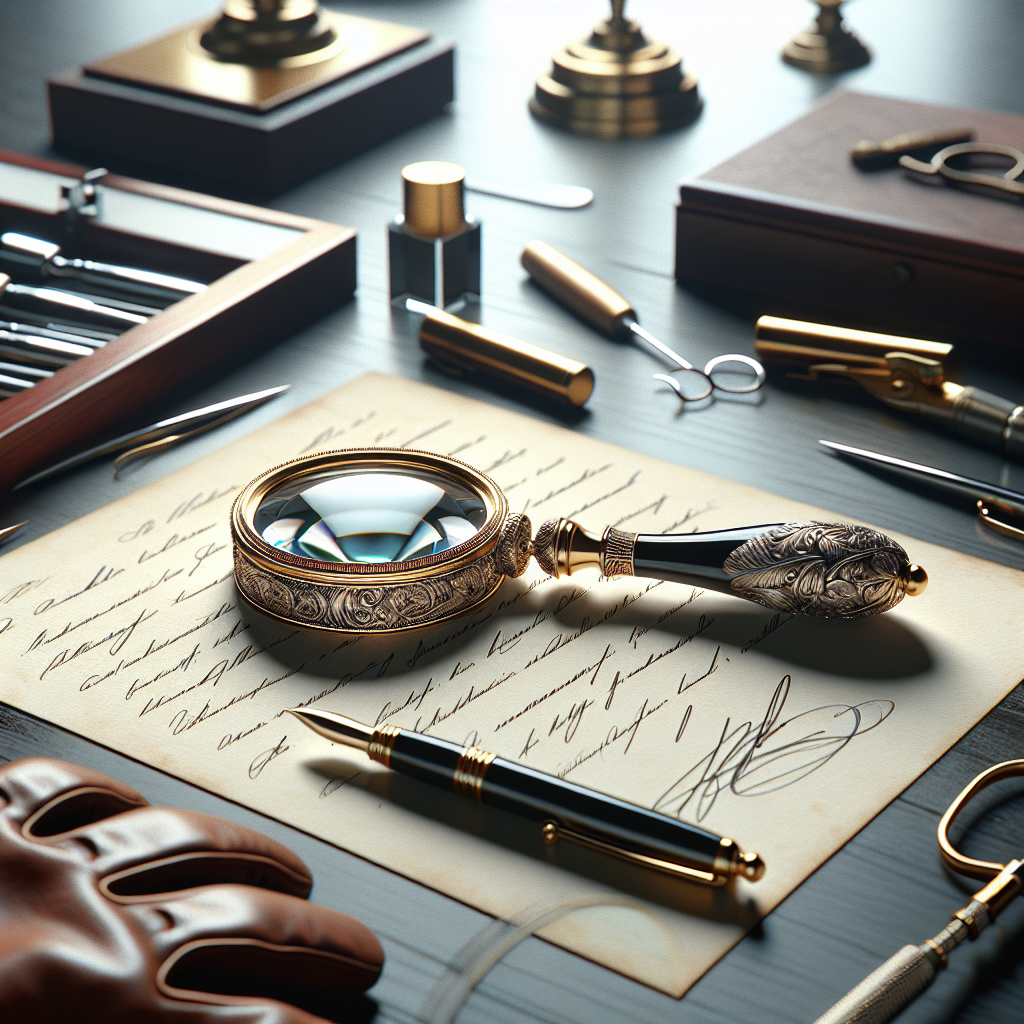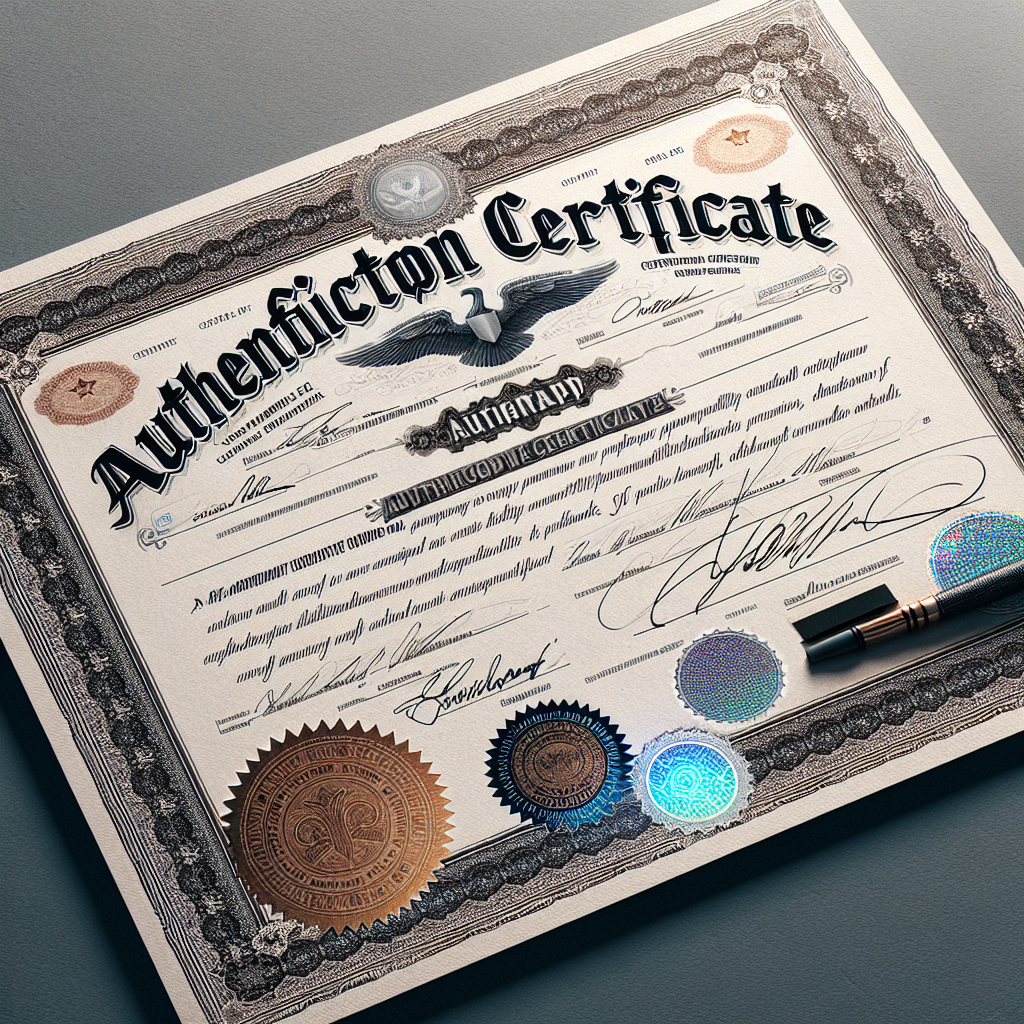Welcome to the fascinating world of collecting where the authenticity of your prized signatures is paramount. The Art of Autograph Authentication is a meticulous process that involves a keen eye and a breadth of knowledge about the autograph industry. It's not just about having a signature on a piece of paper or memorabilia; it's about ensuring that the moment captured is genuinely authentic.
Experts in the field use a combination of techniques to authenticate an autograph. These may include examining the ink and paper used, assessing the signature's flow and consistency, and comparing it against known authentic examples. The pressure of the pen and the aging process of materials are also telling signs. A legitimate autograph will often show a natural variance in pressure and will age uniformly with the medium it's on. Digital analysis tools can also play a part, offering high-resolution insights into the finer details that the human eye might miss.
For collectors and enthusiasts, understanding these methods is crucial in maintaining the integrity of their collections. However, even with knowledge and tools at hand, the process can be daunting. That's where BAM! Autographs steps in. With years of experience and a trailblazing spirit in autograph verification, BAM! Autographs provides certainty to collectors who wish to ensure their autographs are the real deal.
Ready to discover the authenticity of your memorabilia? Check out all of the different autographs available at bamautographs.com. Stay tuned as we delve deeper into the specifics of autograph authentication and share expert tips to help you become savvy in spotting the genuine from the faux.
Key Steps in the Authentication Process

To ensure the authenticity of an autograph, professionals follow a series of key steps that form the backbone of the authentication process. This methodical approach helps to safeguard against forgeries and maintain the value of autographed collectibles.
Firstly, the provenance of the autograph is investigated. This involves tracing the history of the item to ascertain its origins and previous ownership. A well-documented lineage can significantly enhance the credibility of the autograph.
Next, experts scrutinize the autograph itself. They look for tell-tale signs of authenticity, such as the characteristic traits of the signer's handwriting. The materials used are also examined; genuine autographs tend to use period-appropriate ink and paper.
Comparative analysis is another critical step. Authenticators compare the signature in question with an extensive library of verified signatures. Discrepancies in handwriting, ink flow, and other idiosyncrasies can raise red flags.
Condition and preservation are also taken into account. Factors such as fading, paper quality, and signs of aging must be consistent with the time when the autograph was supposedly signed.
In more challenging cases, forensic methods such as ultraviolet light tests and microscopic examinations can be employed. These techniques can reveal alterations, hidden markings, and other indicators that might not be visible to the naked eye.
Finally, a certificate of authenticity (COA) is often issued for verified autographs. This document provides additional assurance to buyers and collectors that the autograph they are acquiring has been thoroughly vetted by experts.
Each of these steps requires a deep understanding of the nuances of autograph authentication, ensuring that collectors can confidently build their collections with genuine signatures.
Understanding Autograph Authentication Services

Autograph authentication services are specialized entities that collectors and dealers rely on to verify the legitimacy of signed memorabilia. Understanding the role and processes of these services is crucial for anyone involved in the collection or sale of autographed items.
Authentication services are typically staffed by experts with years of experience and a keen eye for detail. These professionals have studied countless signatures and possess a vast knowledge of signature variations, including the stylistic changes that may occur over time.
The services provided are grounded in meticulous research and the use of advanced technology. Authentication companies maintain extensive databases of authentic signatures to which they compare items submitted for verification. They also stay up-to-date on known forgeries and commonly forged signatures, which helps in quickly identifying suspect items.
Many authentication services offer different levels of evaluation, from quick preliminary opinions to full, in-depth analysis. The latter often includes the use of forensic techniques and detailed reports of the findings. The outcome is usually a certificate of authenticity or a detailed letter of opinion, providing both reassurance and a form of insurance for the item's value.
It is important for collectors to choose a reputable authentication service, as the COA is only as trustworthy as the company that issues it. Leading authentication services are recognized within the industry for their rigor and reliability, and their certification can greatly influence the market value of an autograph.
Collectors should also be aware that the authentication process typically incurs a fee, which can vary based on the item's value, the level of service chosen, and the renown of the signer. Investment in a reputable authentication service can, however, ensure peace of mind and protect against the financial loss associated with purchasing a forgery.
Tools and Techniques for Autograph Verification

When it comes to verifying the authenticity of an autograph, experts employ a variety of tools and techniques to ensure that collectors can confidently authenticate an autograph. One fundamental approach is the visual examination, which involves scrutinizing the signature under magnification to detect any irregularities or signs of forgery. Experts look for telltale signs such as shaky handwriting or ink that indicates multiple strokes, which can suggest that a signature was slowly drawn rather than swiftly signed.
Another key tool is the use of ultraviolet (UV) light, which can reveal if different types of ink have been used in the signature. This is important because forgers may try to age a signature artificially, and UV light can expose these inconsistencies. Additionally, experts can use infrared light to analyze the paper itself for any underlying marks or erasures that are not visible to the naked eye.
Forensic analysis can also come into play, including the examination of paper fibers to determine the age of the material or the use of chemical analysis to identify the type of ink used. Such detailed investigations can be pivotal in confirming an autograph's age and whether it aligns with the period when the signer was known to be active.
Digital technology has also enhanced the ability to authenticate autographs. High-resolution imaging allows for the comparison of signatures against authentic exemplars in databases, and software can analyze the pressure and flow of the signature to determine its authenticity.
It's important to remember that no single tool or technique can conclusively authenticate an autograph. It's the combination of these methods, along with the expertise of the authenticator, that leads to a reliable assessment. Collectors should always seek out services that use a comprehensive approach to autograph verification.
Common Pitfalls in Autograph Authentication

Even for the seasoned collector, the process to authenticate an autograph can be fraught with challenges. One common pitfall is the reliance on a Certificate of Authenticity (COA). While a COA can be a useful piece of evidence, it is not infallible. Some COAs are issued by less reputable sources and can be easily forged. Collectors are advised to consider the reputation of the issuer and to verify the COA's legitimacy.
An over-reliance on exemplar signatures can also lead to errors. Signatures can vary over time due to age, health, or circumstance, meaning that not all authentic signatures will match exemplars perfectly. Therefore, it's crucial to consider the context of the signature and to use a range of exemplars from different periods of a signer's life.
Another pitfall is ignoring the provenance of the item. A well-documented history of where an autograph has come from can be as important as the signature itself. Provenance can help establish the authenticity of an autograph, but it is often overlooked or undervalued by collectors.
Finally, the human factor can introduce bias and error. Authenticators must remain objective and not allow their personal feelings about a piece of memorabilia or the person who signed it to affect their judgement. Staying up to date with the latest techniques and understanding the nuances of signature analysis are vital to avoid misauthentication.
Understanding these common pitfalls is essential for collectors. By being aware of these issues and approaching autograph authentication with a critical eye, collectors can better protect themselves against forgeries and ensure that their treasured items are genuine.
Protecting Your Autograph Collection
Check out all of the different autographs available at bamautographs.com. Once you've taken the time to authenticate an autograph, it's equally important to protect your memorabilia from damage. Environmental factors such as light, humidity, and temperature can degrade autographs over time. To prevent fading, store autographs out of direct sunlight and in stable, moderate climates. Acid-free sleeves, frames with UV-protective glass, and archival storage boxes can offer additional layers of protection.
Another key aspect of protection is insurance. Ensure that your collection is properly appraised and insured, so that you're covered in case of loss, theft, or damage. Regularly update your inventory with descriptions and photographs of each item. This meticulous record-keeping not only aids in insurance claims but also adds to the provenance of your collection.
Digital backups can also serve as a safeguard for your collection. Scanning or photographing your autographed items creates a digital archive that can be invaluable for documentation and recovery purposes.
Engaging with a community of fellow collectors can be beneficial as well. Sharing tips, experiences, and best practices helps everyone to stay informed about the best ways to care for their autographs.
By following these guidelines, collectors can ensure that their autographs remain in pristine condition, preserving both their sentimental and monetary value. Remember, the joy of collecting is not just in the acquisition but in the ongoing care and maintenance of your treasured memorabilia.
Discover the perfect addition to your collection at BAM! Autographs.

